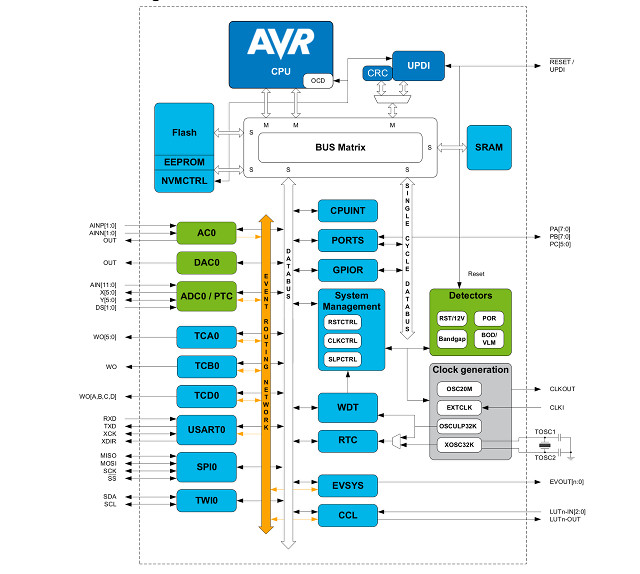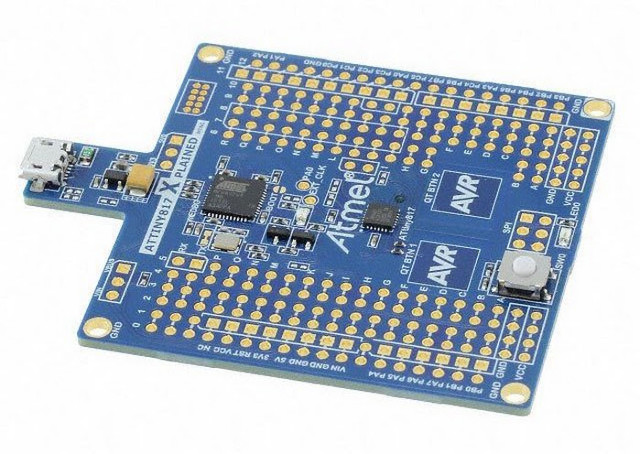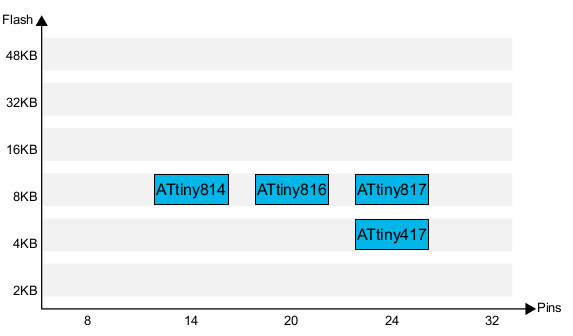Microchip’s latest Atmel tinyAVR MCUs combine Atmel 8-bit AVR core with CIPS (Core Independent Peripherals) normally found in the company’s PIC MCUs. Since Atmel’s purchase by Microchip, I believe this is the first time the company leverages features from both MCU families.
The four new ATtiny MCUs come with 4 to 8 KB flash, and up to 24 pins:
- ATtiny417 – 8-bit Atmel AVR MCU with 4KB Flash, 256 bytes SRAM, 128 bytes EEPROM, 20MHz/20 MIPS, two 16-bit timer/counters, one 12-bit timer/counter, RTC, USART, SPI, Two-wire Interface (I2C), 10-bit ADC, 8-bit DAC, analog comparator, accurate internal oscillators and multiple calibrated voltage references, Custom Logic, 10-bytes unique ID, and 24 pins
- ATtiny814 – Same as above but with 8KB flash, 512 bytes SRAM, Peripheral Touch Controll (PTC), and 14 pins
- ATtiny816 – Same key features as ATtiny814 but with a 20-pin package with more I/Os
- ATtiny817 – Same key features as ATtiny814 but with a 24-pin package with more I/Os

“Core Independent Peripheral” is pretty much self-explanatory, but Microchip description can be useful nonetheless:
CIPs allow the peripherals to operate independently of the core, including serial communication and analog peripherals. Together with the Event System, that allows peripherals to communicate without using the CPU, applications can be optimized at a system level. This lowers power consumption and increases throughput and system reliability.
The new MCUs will be supported by Atmel START, an “online tool for intuitive, graphical configuration of embedded software projects”, as well as Atmel Studio 7 software development tools. You’ll be able to experiment pretty quickly thanks to ATtiny817 Xplained Mini Kit with a micro USB port for power and programming, a button, and access to all I/Os from the MCU. The board is also said to be compatible with Arduino ecosystem.
 The new 8-bit tinyAVR MCUs are available now in QFN and SOIC packages with pricing starting at $0.43 for 10K units. Xplained Mini Kit can be purchased for $8.89 on Digikey. Visit Atmel tinyAVR product page for full technical details about the new MCUs.
The new 8-bit tinyAVR MCUs are available now in QFN and SOIC packages with pricing starting at $0.43 for 10K units. Xplained Mini Kit can be purchased for $8.89 on Digikey. Visit Atmel tinyAVR product page for full technical details about the new MCUs.
Thanks to Nanik for the tip.

Jean-Luc started CNX Software in 2010 as a part-time endeavor, before quitting his job as a software engineering manager, and starting to write daily news, and reviews full time later in 2011.
Support CNX Software! Donate via cryptocurrencies, become a Patron on Patreon, or purchase goods on Amazon or Aliexpress





